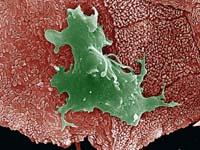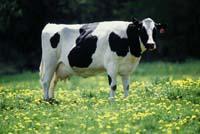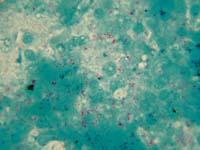Felix Bastida Corcuera: "Trikomoniasis is not well known, but it is widespread"

After studying Veterinary, Medicine and Health at the University of Zaragoza, I went to the Veterinary School of Cornell University in the United States to study PhD studies, where I studied, among other things, the grape pain produced by the bacteria Staphylococcus aureus. It is a bacterium that has many problems in the udders of the cows and to cure them I started to develop a vaccine. Then, continuing with the research of infectious diseases of cows, I studied a postdoctoral degree at the School of Medicine of the University of California of San Diego (UCSD). I studied especially two allotypes of bovine immunoglobulin (IgG2), and studied whether or not one of them protected cows from these infectious diseases. I also researched the cow pathogen sexually transmitted by Tritrichomonas foetus. There is a kind of human pathogen: Trichomonas vaginalis . Precisely in the last six years I have been researching the pathogenesis and molecular biology of this pathogen at the California University of Los Angeles (UCLA).
About a year ago the prestigious scientific journal Science published the work that revealed the sequencing of the genome of the pathogen Trichomonas vaginalis. I worked in collaboration with the team of researchers at the University of California in Los Angeles.
Trichomonas vaginalis is a sexually transmitted infection that only affects humans. Trikomoniasis is little known, but it is widespread, there are about 270 million people infected. However, it is not yet treated correctly or investigated because it does not directly kill anyone. It produces vaginitis in women and, often, man carries a disease without symptoms, that is, a carrier that facilitates the spread of the infection. In fact, doctors often treat women and men not because they don't notice symptoms. Consequently, the woman is at risk of becoming infected again, as it should not be forgotten that it is a sexually transmitted disease.
In this sense, it seems that in women there are more cases of this disease than in men. However, I believe that the problem lies partly in the diagnosis of the disease. Taking a sample of the female vagina is a simple task, while collecting the urine of men is insufficient to detect the parasite.

The activity of the pathogen Trichomonas vaginalis depends on the energy it accumulates. The energy is stored in an organ of the parasite itself, the hydrogenosoma (similar to the mitochondria of our cells). Treatments to combat the disease are aimed in some way at the elimination of this energy, but they are not yet entirely effective. That is the challenge.
Until a few years ago it was thought that the only consequences of this disease were inflammation, odor, irritation and itching of the genital organs, being cured with antibiotic Metronidazole. It is now confirmed that such a similar parasite ( Tritrichomonas foetus) causes sterility and death of embryos in cows. This has not been fully confirmed in humans, but experts believe it can be an obvious source of sterility. Undoubtedly, this has increased the investigative spirit. In addition, it has been proven that this infection increases the chances of suffering AIDS.
The damage caused by the parasite depends on the ability of the parasite to attach to the walls of the vagina, which depends on certain proteins. Some of these proteins have been identified (AP65, AP51, AP33 and AP23). Therefore, the identification of the genes responsible for the synthesis of these proteins can be fundamental in finding ways to combat the disease. Something similar can be said of the energy supply of the microorganism. It allows to understand and transform the genetic bases of the activity of hydrogenosoma.
Therefore, it is important to know the genome of this bacterium to know the virulence factors and to be able to find new drugs. In fact, there are studies that show that this microorganism has several mechanisms of resistance to current therapies.

The genome of the pathogen Trichomonas vaginalis is one of the largest genomes ever found in a unicellular parasitic eukaryote. We have seen that it has a large and repetitive genome. Sequencing repetitive genomes is an arduous task, as computational algorithms do not work well with so much information. However, we managed to sequence approximately 26,000 genes. We have identified the functions of most of them, but many remain unsolved mysteries.
Indeed. When scientific research began to move in Euskal Herria I contacted the Neiker-Tecnalia technology center. In fact, this technology center decided to create a technology-based company that took advantage of the researchers' knowledge to try to market animal health products. That is why I returned to Euskal Herria and since then I have been at Vaccinek as director.

We have two main lines of research: the line of research in vaccines against paratuberculosis and the line in charge of developing kits for the diagnosis of infectious diseases in animals. The first line of research aims to obtain characteristic and effective vaccines against paratuberculosis that can be used in cattle. The second line of research develops, produces and markets diagnostic kits for this infectious disease and others. These kits are mainly based on PCR technique.
Currently I work mainly in obtaining vaccines against paratuberculosis.
It is a chronic disease of the digestive system of cows, sheep and goats, mainly ruminants. However, it can also appear on deer, rabbits, or other animals. It causes persistent diarrhea that treatment often cannot cope with. Mycobacterium avium subsp. It is a disease caused by the bacteria better known as paratuberculosis or M. paratuberculosis. The growth of this bacteria is very slow, so it takes years for clinical symptoms to appear.
It is a widespread infection in the world. In addition, M. paratuberculosis also believes that it may have something to do with the human Crohn. However, it is not yet very clear.

The market for paratuberculosis vaccines is very broad. However, today there is only one vaccine for sheep and it is not entirely perfect. When the animal is introduced an immune response to tuberculosis occurs, as the bacteria M. paratuberculosis and tuberculosis bacteria belong to the same family. Therefore, a cross-reaction occurs with the diagnostic test. Therefore, the authorities prohibit this vaccine for cattle.
Our goal is to find a vaccine against paratuberculosis that does not produce cross-reactions with tuberculosis.
Buletina
Bidali zure helbide elektronikoa eta jaso asteroko buletina zure sarrera-ontzian











